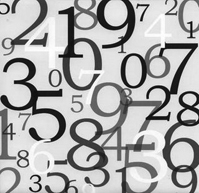The Power of Six and Why there are Seven Days a Week

 |
| Mathemagic |
We know a great amount about what the Babylonians did because, unlike the Egyptians writing on papyrus that eventually rots away, they made indentations in clay using a wedge-shaped stick called a stylus. The clay then hardened and examples of the things they did mathematically have survived for us to see: shopping lists, small business accounts, school work, even mathematical research.
The ancient Babylonians had a maths system that was so very simple. They managed to represent all their numbers using two symbols to represent 1 and 10—1 was the starting point and 10 was chosen because we have 10 digits on our hands. And then the symbol for 1 with a space next to it was used to represent 60, and 1 with two spaces was used to represent 3600. Why they chose 60 and 3600, which is 60 × 60, probably has a lot to do with the calendar.
Direction in the heavens
In ancient times, star-gazing was of major importance. Now the stars in the heavens have no apparent pattern unless, that is, you invent one. So that is what happened. Groups of stars and their abstract but never-changing shapes were memorized, given names and legendary stories, and taught to each new generation.
The most important star pattern even today is the Great Bear—also the Plough or Big Dipper, so called in the US because it looks like a saucepan, small versions of which were chained to water fountains so people could quickly dip it for a drink.
Follow the star pattern of the Big Dipper, along the bent handle, into the pan along the bottom. Now pass up the other side, and continue in a straight line and you come quite soon to the most unique star in the heavens; the only one that never changes its position. This is the Pole Star. Locate this star and you have located north, from which you can work out any other direction. For hunters or travellers, though the entire heavens revolved, the Pole Star was always directly North and from that they knew the direction they were heading.
In watching and recording the stars' patterns and their movements, slightly north and south and back again, and comparing the movement to the seasons and the availability of food, the Babylonians calculated the length of a year at around 365 days. But that is a complicated and awkward number. How do you divide 365? Divide by 5 and you get 73, which is a prime number. There are no other divisors. So for a 365 day year, you could have 73 weeks of 5 days, or 5 months of 73 days, neither of which are comfortable in mathematical terms.
Making it easy
So the Babylonians made things easier by declaring that the year was 360 days long. What a beautiful number. It divides so easily into smaller portions. It can be divided evenly by 2, 3, 4, 5, 6, 8, 9, 10, 12, 15, 18, 20, 24, 30, 36, 40, 45, 60, 72, 90, 120, and 180. Their choice of ways of dividing the year into manageable bits was enormous, but they settled on 12 months of 30 days; what could be neater?
An Easy Way to Count to Thirty
The Babylonians may have found a way to count up to 30 on their fingers. It’s a very simple system. Count the fingers on one hand, 1, 2, 3, 4, 5. Now count 6 with the thumb of the other hand and go through the first hand again, 7, 8, 9, 10, 11, and now the first finger of the other hand becomes 12. In this way, your second hand counts 6, 12, 18, 24, 30; a very neat way to teach young kids to count to 30 on their fingers.
As a year is a circle or a cycle, once the Babylonians had divided the year into 360 days, it was quite natural to divide the circle into 360 degrees and because 360 is so easy to do maths with, their geometric maths blossomed. The Chinese also calculated the length of the year at around 365 days. They then tried to do circular maths by dividing the circle into 365 portions and found it so complex that they gave up circular mathematics for around 1,000 years, by which time the Babylonian method had reached them.
Have You Seen...?
Now although the Babylonians chose 30 days for a month, they chose 60 as a number symbol. Why? Probably because 6 is such a magical number. Six is a perfect number as it is the sum of all the numbers that divide into it, 1 + 2 + 3 = 6. The next perfect number is 28, as 1 + 2 + 4 + 7 + 14 = 28 and as that was roughly the number of days in a lunar cycle, (actually it’s 27.25 days) it was all considered very magical. 28 divided by 4 gives us 7 and eventually that was chosen as the length of a week.
So, besides inventing the wheel, the Babylonians creating a system of numbers based on 60s that couldn’t be simpler. Even today we still divide the hour into 60 minutes and 60 seconds, based on their ancient system. The legacy left by the ancient Babylonians and the mathematicians of
By Johnny Ball
Johnny Ball is a BAFTA-award winning popularizer of mathematics and sciences whose television shows included Think of a Number and Johnny Ball Reveals All. He continues to make appearances and lectures throughout the country.He first did the article above for Encarta.
